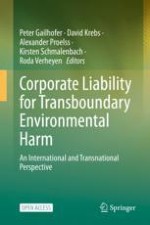16.1 Article 8 of the Paris Agreement: Loss and Damage
16.2 Responsibility, Liability and Compensation
16.3 Terminology of Paragraph 51 of COP Decision 1/CP.21
States shall develop national law regarding liability and compensation for the victims of pollution and other environmental damage. States shall also cooperate in an expeditious and more determined manner to develop further international law regarding liability and compensation for adverse effects of environmental damage caused by activities within their jurisdiction or control to areas beyond their jurisdiction.
